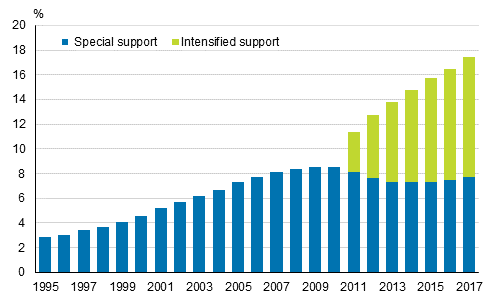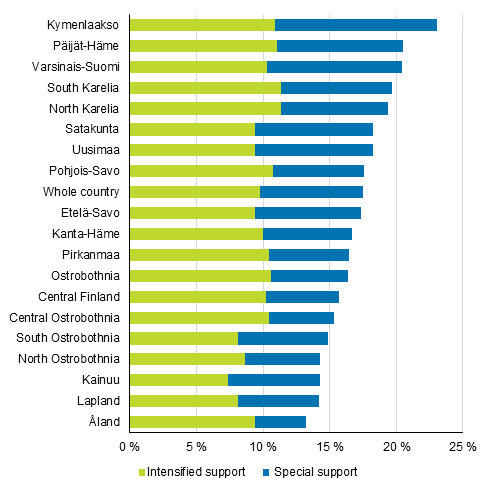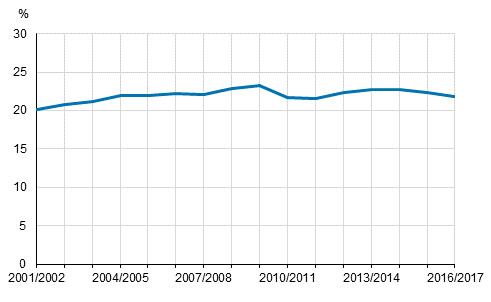Published: 11 June 2018
Increasingly more comprehensive school pupils received intensified or special support
Intensified or special support was received by 17.5 per cent of comprehensive school pupils in autumn 2017. Intensified support was received by 54,300, or 9.7 per cent of comprehensive school pupils and special support by 43,100, or 7.7 per cent of comprehensive school pupils. The share of pupils in intensified support grew from the previous year by 0.8 percentage points and in special support by 0.3 percentage points. These data derive from Statistics Finland’s education statistics.
Share of comprehensive school pupils having received intensified or special support among all comprehensive school pupils 1995–2017, % 1)

1) Pupils accepted or transferred to special education before 2011 have been regarded as equal to pupils having received special support.
Among the recipients of intensified support, 64 per cent were boys and 36 per cent girls. Among the recipients of special support, 71 per cent were boys and 29 per cent girls. In autumn 2017, a total of 556,700 comprehensive school pupils were in pre-primary, basic and post-basic education of the comprehensive school, 51 per cent of whom were boys and 49 per cent girls.
The three levels of the support system for learning and schooling are general, intensified and special support. Of these, a pupil can receive only one level of support at a time. The statistics on special education in comprehensive schools contain data primarily on intensified and special support. In addition, the statistics include information on part-time special education arranged as general support.
The database tables connected to the statistics on special education and the database tables related to statistics on pre-primary and comprehensive education allow examination of support received by pupils by area and place of implementation of teaching, for example. Data on special education in vocational education are collected at the end of the text section of this release and in Appendix table 9.
Intensified support increased steadily in all Mainland Finland regions
In 2017, intensified support was arranged for more pupils than in the year before in all regions except ┼land. The development has been similar in all Mainland Finland regions since 2011, when the national three-step system for learning and schooling was introduced. In 2017, the amount of intensified support increased most in relative terms in Kainuu and Central Ostrobothnia. The share of pupils having received intensified support was highest in South Karelia and North Karelia and lowest in Kainuu. The share of pupils having received intensified support in all pupils was 7 to 11 per cent in different regions.
Share of comprehensive school pupils having received intensified or special support by region 2017, %

The share of pupils having received special support in all comprehensive school pupils varied between 4 and 12 per cent by region. The share of pupils having received special support in Mainland Finland regions was lowest in Central Ostrobothnia and highest in Kymenlaakso. In ┼land, the share of pupils receiving special support was four per cent.
The share of comprehensive school pupils receiving intensified or special support varies between regions. Of the Mainland Finland regions, the combined share of those receiving intensified support was biggest in Kymenlaakso, where 23 per cent of pupils received intensified or special support. The combined shares of those receiving support were smallest in Lapland, Kainuu, North Ostrobothnia and South Ostrobothnia, in all under 15 per cent.
Share of those receiving all education in a special education school falling
Among the recipients of special support, 9.5 per cent received all education in a special education school group in autumn 2017. The share of those receiving all education in a special education school group has fallen yearly; its share was 13 per cent in 2011, it was 12 per cent in 2014, and 10 per cent in 2016. The share of those receiving all education in other than a special education school group has remained unchanged in recent years, at around 28 per cent.
Among the recipients of special support, 37 per cent received all education in a special education group and 21 per cent received all education in a general education group. The remaining 42 per cent received part of the education in a general education group and part in a special education group.
Twenty-four per cent of the pupils receiving special support had extended duration of compulsory education. The shares of extended compulsory education have decreased in recent years.
General syllabus ever more common for special support pupils
Fifty-three per cent of the pupils having received special support in basic and post-basic education of the comprehensive school studied general education syllabuses in all subjects in autumn 2017. The share of those studying according to the general syllabus has grown yearly; its share was 44 per cent in 2011, it was 47 per cent in 2014, and 51 per cent in 2016.
Twelve per cent of the pupils having received special support in 2017 had individualised syllabuses for one subject, 13 per cent for two to three subjects, and 17 per cent for four or more subjects. Five per cent of the pupils receiving special support studied according to functional skill areas. The teaching can be arranged according to functional skill areas if it cannot be arranged by subject syllabuses due to the pupil's severe disability or illness.
Three out of four pupils in intensified support received part-time special education
Seventy-four per cent of the pupils who received intensified support in autumn 2017 received part-time special education, 55 per cent remedial teaching, and 38 per cent special needs assistance and/or interpretation services. Forty per cent of the pupils who received special support received part-time special education, 36 per cent received remedial teaching, and 58 per cent special needs assistance and/or interpretation services.
Twenty-two per cent of comprehensive school pupils received part-time special education
In the school year 2016 to 2017, altogether 120,100 comprehensive school pupils received part-time special education, which was 22 per cent of comprehensive school pupils in autumn 2016. The share has fallen a little from the previous school year.
Share of comprehensive school pupils having received part-time special education among all comprehensive school pupils in academic years 2001/2002 to 2016/2017, %

In autumn 2016, part-time special education was included in intensified support for 37,100 pupils and in special support for 15,700 pupils. By subtracting we can conclude that around 67,300, or 56 per cent, of the 120,100 pupils having received part-time special education in the school year 2016 to 2017 received part-time special education as general support.
At least 29 per cent of comprehensive school pupils received some support for learning and schooling
According to the available statistics, at least 29 per cent of comprehensive school pupils in autumn 2016 received some kind of support in the school year 2016 to 2017. The share has remained unchanged for the past four years. A total of 157,736 students received intensified support, special support or part-time special education as general support in the school year 2016 to 2017.
Ever more students in vocational education received special education
The number of students in vocational education leading to a qualification having received special education has grown at least from 2004 onwards, when the production of these statistics started: 12,500 pupils received special education in 2004, 19,300 in 2010, and 25,400 in 2016. The share of all students having received special education in all students in vocational education leading to a qualification was in the same years five, seven and nine per cent.
In 2016, there were 120,357 students in vocational education for young people (curriculum-based basic vocational education provided by educational institutions), of whom 19 per cent were special education students. Twenty per cent of male students and 18 per cent of female students were special education students. In all, 56 per cent of special education students were men.
Most special education students (86%) in vocational education for young people were studying in vocational education institutions. Thirteen per cent of special education students attended special vocational education institutions and around one per cent other educational institutions providing vocational education.
Eighty-four per cent of special education students in vocational education for young people were studying in the same groups (integrated) with other students.
Source: Education. Statistics Finland
Inquiries: Heli Hiltunen 029 551 3314, koulutustilastot@stat.fi
Director in charge: Jari Tarkoma
Publication in pdf-format (284.8 kB)
- Tables
-
Tables in databases
Pick the data you need into tables, view the data as graphs, or download the data for your use.
Appendix tables
- Appendix table 1. Comprehensive school pupils having received intensified or special support, 2017 (11.6.2018)
- Appendix table 2. Part-time special education, remedial teaching, and special needs assistance and interpretation services received by comprehensive school pupils having received intensified or special support, 2017 1) (11.6.2018)
- Apprendix table 3. Comprehensive school puplis having received intensified support 2011 - 2017 (11.6.2018)
- Apprendix table 4. Comprehensive school pupils having received special support by duration of compulsory education, 2017 (11.6.2018)
- Appendix table 5. Comprehensive school pupils having received special support by place of provision of teaching, 2017 (11.6.2018)
- Appendix table 6. Pupils having received special support on grades 1-9 and during additional education of comprehensive school by subject syllabus, 2017 (11.6.2018)
- Appendix table 7. Comprehensive school pupils having received special support, 1995 - 2017 1) (11.6.2018)
- Appendix table 8. Comprehensive school pupils having received part-time special education from academic year 2001/2002 to academic year 2016/2017 (11.6.2018)
- Appendix table 9. Students of special vocational education by place of provision of teaching, 2004 - 2016 (11.6.2018)
- Appendix table 10. Comprehensive school pupils having received intensified or special support by region in 2017 (11.6.2018)
Updated 11.6.2018
Official Statistics of Finland (OSF):
Support for learning [e-publication].
ISSN=1799-1617. 2017. Helsinki: Statistics Finland [referred: 19.4.2025].
Access method: http://stat.fi/til/erop/2017/erop_2017_2018-06-11_tie_001_en.html

